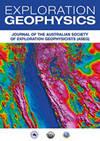水平重力梯度叠加在山区地表密度估算中的应用
IF 0.8
4区 地球科学
Q4 GEOCHEMISTRY & GEOPHYSICS
引用次数: 0
摘要
作者提出了一种新的方法来分析重力梯度张量的微分曲率数据集,用于在没有先验密度假设的情况下评估表层的密度。该方法被称为水平重力梯度叠加-移动窗口相关(HGGS-MWC)方法,基于采集的数据和基于数字高程模型计算的表层微分曲率响应数据之间的连续MWC。为了改善相关性,设计了一种HGGS处理方法并获得了专利。它在MWC处理之前应用于两个数据集。点源微分曲率响应的特点是形成一个独特而对称的象限形状,并将波峰和波谷分布在下面的异常物质上。这些波峰和波槽靠近或远离其中心,这取决于异常物质的深度。这使人们能够设计一个滤波器来增强表层的响应。此外,HGGS处理同时影响重力响应的收缩和深层次表层响应的衰减。HGGS-MWC方法在波数域中产生测量平面固有的质量-表面粗糙度比(MSR)值,并确定表面层质量和表面粗糙度之间的相位关系。MSR是一个很好的指标,表明凸面层下是否存在相对于区域平均质量的质量过剩或不足。对观测数据集的应用是在2008年岩手-宫城内陆地震引发严重山体滑坡的地区进行的。基于150的飞行高度 m、 表层的质量变化,下降到300 m以下,通过分析数据中主要在270–650范围内的波长进行适当评估 m,最高可达1650 m.可以划定低密度沉积物(如可能与高含水量有关的火山灰和浮石)位于陡峭斜坡的高山上的特定区域。这些信息在选择可能进行进一步精确调查的地区方面发挥作用,有助于防灾。波长超过1650的区域密度变化 m仍然没有解决,这是未来研究的一个问题。随着问题的解决,HGGS-MWC方法获得的表层密度分布结果也将用于垂直重力梯度数据和重力数据的地形校正。本文章由计算机程序翻译,如有差异,请以英文原文为准。
Application of horizontal gravity-gradient stack for estimation of surface layer density in mountainous areas
The author proposes a new approach for analysing datasets of the differential curvature of a gravity-gradient tensor for density evaluation of the surface layer without a prior density assumption. The method, called the horizontal gravity-gradient stack–moving window correlation (HGGS-MWC) method, is based on a successive MWCs between the acquired data and the data of differential curvature responses of the surface layer calculated based on a digital elevation model. For improving the correlation, a HGGS processing method was devised and patented. It is applied to both datasets before the MWC processing. A point-source differential curvature response has the characteristic of forming a peculiar and symmetrical shape of a quadrant and distributing peaks and troughs over an underlying anomalous mass. These peaks and troughs are near or far away from their centre depending on the depth of the anomalous mass. This enables one to design a filter to enhance the responses of the surface layer. In addition, the HGGS processing affects both the contraction of the gravitational response and the attenuation of responses from deeper subsurface layers. The HGGS-MWC method leads to the production of values of the mass surface roughness ratio (MSR) in the wavenumber domain that are inherent to the measuring plane of surveys and determines the phase relation between the mass of the surface layer and the surface roughness. The MSR is a good indicator of whether a mass surplus or deficit relative to the regional average mass exists under a convex surface layer. Application to the observed datasets was performed in the area where serious landslides were triggered by the 2008 Iwate-Miyagi inland earthquake. Based on a flight height of 150 m, the mass variations of the surface layer, which is down to 300 m below the surface, are properly evaluated by analysing the wavelengths in the data mainly within the range of 270–650 m and perceivably up to 1,650 m. The specific areas can be delineated where low-density deposits, such as possible volcanic ashes and pumices associated with high water content, sit on high mountains with steep slopes. The information is useful for disaster prevention by playing a role in selecting potential areas for conducting further precise surveys. Regional density variations whose wavelengths are longer than 1,650 m remain unsolved and are an issue for future studies. With the issue solved, the results for the density distribution of the surface layer obtained by the HGGS-MWC method will serve for terrain corrections of the vertical gravity-gradient data and gravity data as well.
求助全文
通过发布文献求助,成功后即可免费获取论文全文。
去求助
来源期刊

Exploration Geophysics
地学-地球化学与地球物理
CiteScore
2.30
自引率
0.00%
发文量
33
审稿时长
>12 weeks
期刊介绍:
Exploration Geophysics is published on behalf of the Australian Society of Exploration Geophysicists (ASEG), Society of Exploration Geophysics of Japan (SEGJ), and Korean Society of Earth and Exploration Geophysicists (KSEG).
The journal presents significant case histories, advances in data interpretation, and theoretical developments resulting from original research in exploration and applied geophysics. Papers that may have implications for field practice in Australia, even if they report work from other continents, will be welcome. ´Exploration and applied geophysics´ will be interpreted broadly by the editors, so that geotechnical and environmental studies are by no means precluded.
Papers are expected to be of a high standard. Exploration Geophysics uses an international pool of reviewers drawn from industry and academic authorities as selected by the editorial panel.
The journal provides a common meeting ground for geophysicists active in either field studies or basic research.
 求助内容:
求助内容: 应助结果提醒方式:
应助结果提醒方式:


